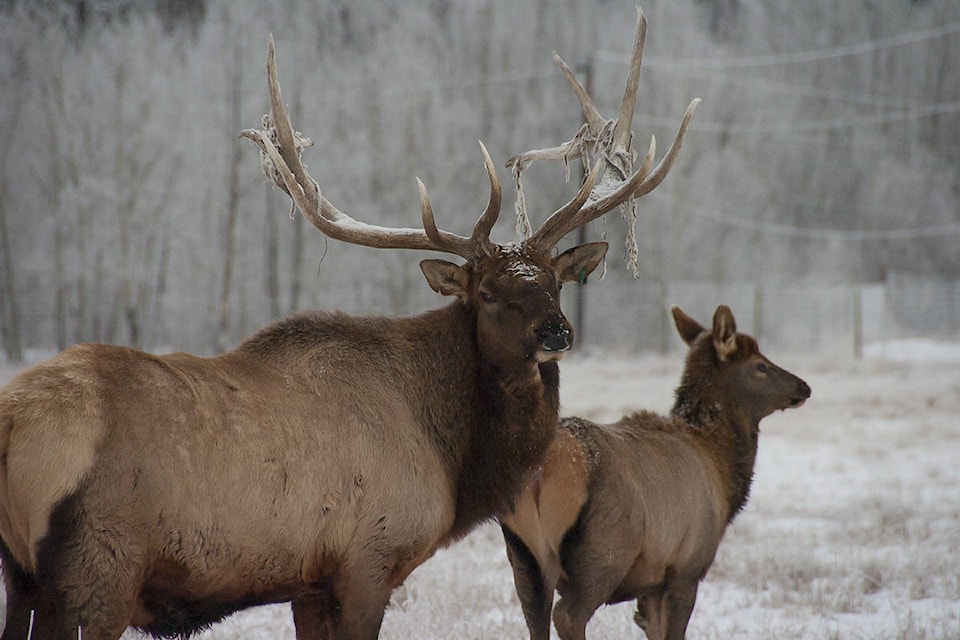Managing the Takhini and Braeburn elk herds is about more than just agriculture conflict and cost, says an Environment Yukon official.
“I think this is a wildlife management challenge we are working with alongside agriculture … it’s not a new challenge. Anywhere you have agriculture, you have wildlife conflict,” said Karen Clyde, lead branch operator for Environment Yukon. “We all have a stake in trying to get through this challenge…. We have worked really closely with the agriculture industry to try to address this issue.”
“This isn’t just about agriculture, this is about a population which provides hunting opportunities and wildlife viewing opportunities.”
The management of Yukon’s elk has recently been the subject of some debate amongst politicians, farmers and conservationists.
In late October 2017, Lake Laberge MLA Brad Cathers called for changes to the way the Yukon manages the animals, due to concerns among some of his constituents about recurring damage by the animals to their crops and farms. He wanted to see more hunting of the animals permitted, changes to the way problem animals are handled, and a reduction of the number of animals to 100, the population recommended in the 1990 elk management plan.
Figures from Environment Yukon’s agriculture branch show a plan to compensate farmers for damage caused by the elk doled out $91,400 over the last three years. It spent another $84,600 over the same period farmers pay for elk prevention measures, such as fencing.
Elk are currently managed via a permitted hunt, which is allowed only in buffer and exclusion zones. There is a closed “core area” where the animals cannot be hunted at all, buffer areas where they are open to hunting when in season via permit, and an exclusion zone where animals can be hunted year round, a step designed to limit their range.
Yukon’s elk are an introduced species, with the exception of animals which occasionally migrated up from British Columbia into the southern tip of the territory. The Braeburn and Takhini River herds were originally introduced in 1951 with imported animals in an attempt to take pressure off of other game species in the region, but the population has never grown to levels which can be sufficiently harvested to have have the original desired impact.
In 2017, there were three hunting permits issued for elk. An issued permit does not guarantee a kill, only the opportunity to harvest an animal.
While the “elk-agriculture conflict was a big driver in the 2016 elk management plan,” Clyde said elk have values other than sport hunting, such as wildlife viewing, and that the animals are being managed in the public interest.
“We have been through fairly extensive consultation through the management plans,” said Clyde, “There is support out there for having elk.”
The Yukon government spent nearly $70,000 on monitoring the Takhini River and Braeburn elk herds between April 1, 2012 and Nov. 9, 2017.
That means an average of approximately $14,000 per fiscal year.
The most recent numbers put herd estimates at 260 animals — 200 in the Takhini herd and 60 in the Braeburn herd. That means an average annual cost of $54 per animal per fiscal year.
The government also spent an additional $42,300 on elk management planning and implementation over a the four year fiscal period between 2014 and the present. The report notes that from April 1, 2017 to Nov. 9, 2018, no money was spent on monitoring, because the majority of activity for that fiscal period will occur in March 2018.
The figures, obtained through an access to information request, do not include staff time. There is one full-time ungulate biologist who spends “approximately 10 per cent of their time on elk,” according to the ATIPP report and one planning person who spends approximately 20 per cent of their time on elk.
The amount of time conservation officers have spent on elk since 2010 is “approximately 10 per cent of one full-time employee,” the report said.
The numbers also do not include the costs associated with managing the elk permit hunt authorization, which includes things like issuing permits and heath testing of harvested specimens, the report notes.
The News filed an access to information request following several unmet requests directly to the Department of Environment. The department initially said it was too difficult to get those numbers.
In an earlier interview, Clyde said that these numbers “were not a simple answer to put together.”
Additionally, in 2008, winter ticks were found in the elk, causing them to be penned and overwintered for treatment and monitoring, over fears the parasite would spread to native moose. Winter ticks are a parasite which attaches to animals like deer and moose, and can harm their health when the infestation is severe. Clyde said the department was not sure if the parasites had come from the elk themselves or from horses.
Managing the issue cost $270,000 between 2008 and 2013, including $100,000 in the 2009-2010 fiscal year, Clyde said.
Contact Lori Fox at lori.fox@yukon-news.com
